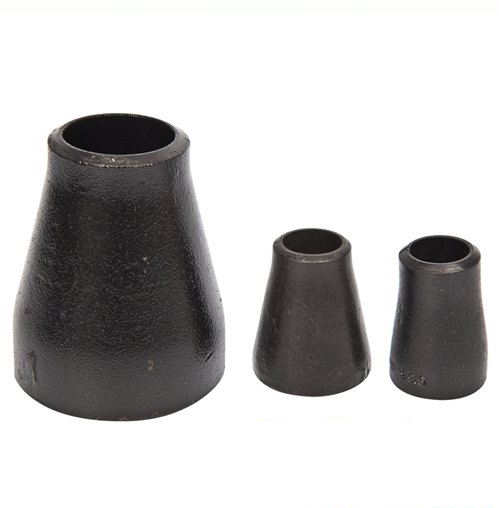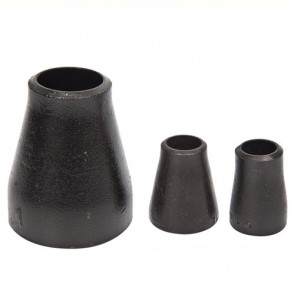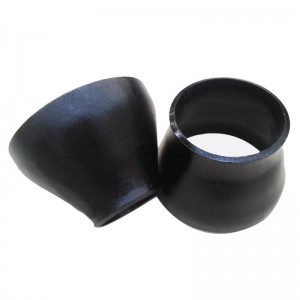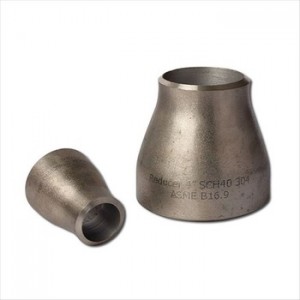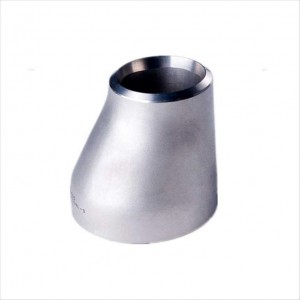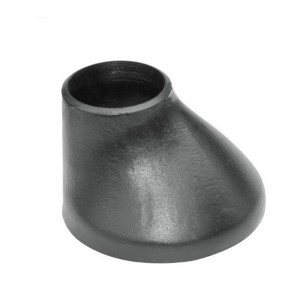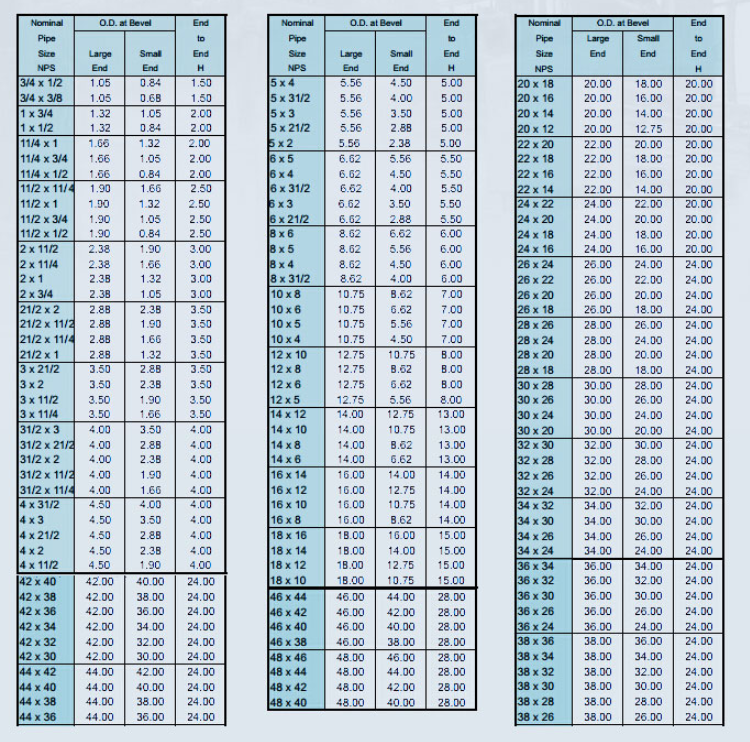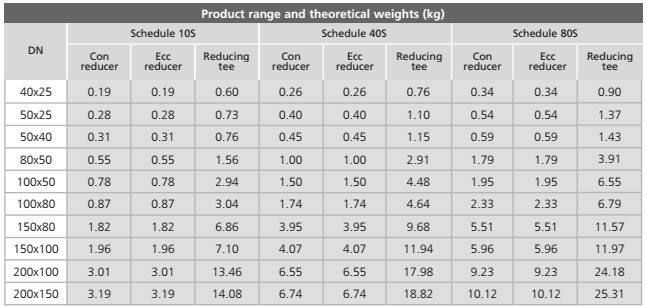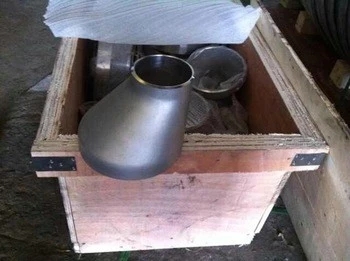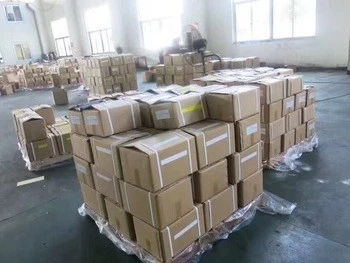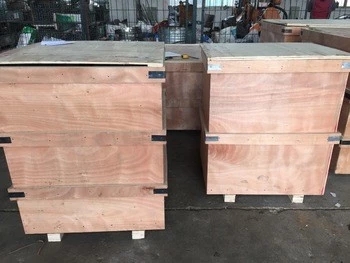Переходник из стальной трубыкомпонент, используемый в трубопроводах для уменьшения их размеров от большого до малого диаметра в зависимости от внутреннего диаметра. Длина сокращения здесь равна среднему значению меньшего и большего диаметров трубы. Здесь редуктор можно использовать в качестве насадки. Редуктор помогает обеспечить соответствие существующим трубопроводам различных размеров или гидравлическому потоку в трубопроводных системах.
1. Типы материалов трубных переходников
Редуктор из углеродистой стали против редуктора из нержавеющей стали
Редукторы могут быть изготовлены из углеродистой стали, сплава или нержавеющей стали и многого другого. По сравнению с редуктором из нержавеющей стали, редуктор из углеродистой стали обладает устойчивостью к высокому давлению, более высокой прочностью и износостойкостью, но легко подвергается коррозии.
Стандарты и марки материалов переходников из углеродистой стали:
A234 WPB, A420 WPL6, MSS-SP-75 WPHY 42, 46, 52, 56, 60, 65 и 70.
Для редуктора из нержавеющей стали:
ASTM A403 WP 304, 304L, A403, 316, 316L, 317, 317L, 321, 310 и 904L и т. д.
Для переходника из легированной трубы:
A234 WP1, WP5, WP9, WP11, WP22, WP91 и т. д.
2. Типы редукторов
Существует два типа редуктора: концентрический переходник и эксцентриковый переходник.
Концентрический редуктор
Этот переходник состоит из фитингов симметричной и конической формы, которые одинаково увеличивают или уменьшают диаметр относительно центральной линии. Например, когда труба диаметром 1 дюйм переходит в трубу ¾ дюйма, верхняя или нижняя часть трубы не остается ровной. Он широко используется при изменении одного или нескольких диаметров.
Эксцентриковый редуктор
Фитинг конической формы, который уменьшает или увеличивает диаметр, но не симметричен относительно центральной линии. Используется в трубопроводных системах для уменьшения диаметра трубы с одного размера на больший или меньший.
Отличия концентрического переходника и эксцентрикового переходника
Концентрические переходники широко используются, тогда как эксцентриковые переходники применяются для поддержания верхнего и нижнего уровня трубы. Эксцентриковые переходники также позволяют избежать захвата воздуха внутри трубы, а концентрический переходник устраняет шумовое загрязнение.
3. Процесс производства переходника для стальных труб.
Существуют универсальные процессы производства редукторов. Они изготавливаются из сварных труб с необходимым наполнителем. Однако трубы EFW и ERW не могут использовать переходник. Для изготовления кованых деталей используются различные методы, включая процессы холодной и горячей штамповки. Он включает в себя «Метод внешней матрицы».
4. Метод внешнего диаметра
Это наиболее распространенный метод изготовления переходника для стальных труб. Труба разрезается и прессуется во внешней матрице, при этом один конец трубы сжимается до меньшего размера. Этот метод подходит для изготовления редукторов малых и средних размеров.
5. Типы соединений трубного переходника
В зависимости от типа соединения трубный переходник можно разделить на переходник для сварки в раструб и переходник для стыковой сварки.
Переходник для раструбной сварки и переходник для стыковой сварки
Переходник для раструбной сварки, также называемый вставкой для раструбной сварки, имеет три типа: 1, 2 и 3. Производственные стандарты соответствуют ASME B16.11.
Муфтовая сварка выдерживает половину прочности стыковой сварки, поэтому ее используют для труб малого диаметра, имеющих диаметр NPS 2 или меньше. Стыковая сварка обладает хорошей прочностью, так как подходит для трубопроводов высокого давления и температуры.
Концы переходника для стыковой сварки в плане или со скосом, изготовленные в соответствии с ASME B16.9 и процессом сварки в соответствии с ASME B16.25.
6. Применение переходников для стальных труб.
Использование стального редуктора осуществляется на химических заводах и электростанциях. Это делает систему трубопроводов надежной и компактной. Он защищает систему трубопроводов от любого неблагоприятного воздействия или термической деформации. Когда он находится на прижимном круге, он предотвращает любые утечки и прост в установке. Переходники с никелевым или хромовым покрытием продлевают срок службы изделия, что полезно для линий с высоким содержанием пара, и предотвращает коррозию.
Трубный переходник, переходные фитинги
Доступные переходники для стальных труб бывают концентрических и эксцентрических типов. Переходники для труб являются подходящими компонентами трубопроводов, позволяющими уменьшить диаметр труб от больших до малых. Входные и выходные концы переходников для стальных труб и переходников для труб из сплавов совпадают с общей осевой линией.
Редукторы могут быть изготовлены из углеродистой стали, сплава или нержавеющей стали и многого другого. По сравнению с редуктором из нержавеющей стали, редуктор из углеродистой стали обладает устойчивостью к высокому давлению, более высокой прочностью и износостойкостью, но легко подвергается коррозии.
Стандарты и марки материалов переходников из углеродистой стали:
A234 WPB, A420 WPL6, MSS-SP-75 WPHY 42, 46, 52, 56, 60, 65 и 70.
Для редуктора из нержавеющей стали:
ASTM A403 WP 304, 304L, A403, 316, 316L, 317, 317L, 321, 310 и 904L и т. д.
Для переходника из легированной трубы:
A234 WP1, WP5, WP9, WP11, WP22, WP91 и т. д.
Легкое промасливание, черная покраска


